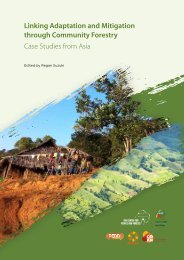Desktop Study on - Regional Climate Change Adaptation ...
Desktop Study on - Regional Climate Change Adaptation ...
Desktop Study on - Regional Climate Change Adaptation ...
You also want an ePaper? Increase the reach of your titles
YUMPU automatically turns print PDFs into web optimized ePapers that Google loves.
<str<strong>on</strong>g>Desktop</str<strong>on</strong>g> <str<strong>on</strong>g>Study</str<strong>on</strong>g><br />
country’s poverty shows that 5.1% of households<br />
are living below the poverty line in 2002. The adult<br />
literacy rate was 92% in 2008. In the UN Human<br />
Development Index, Malaysia ranks 66th out of in<br />
total 182 countries in 2009. Regarding the ec<strong>on</strong>omic<br />
activity, out of the total US$ 186,720 milli<strong>on</strong> GDP in<br />
2007, 10% was provided through the agricultural<br />
sector, 48% through the industrial sector, and 42%<br />
through the service sector.<br />
<strong>Climate</strong> Risk Situati<strong>on</strong><br />
Current Climatic C<strong>on</strong>diti<strong>on</strong>s<br />
The general characteristic features of the climate of<br />
Malaysia are uniform temperature, high humidity<br />
and copious rainfall. Seas<strong>on</strong>al variati<strong>on</strong>s in climate<br />
are more evidently marked by rainfall patterns; the<br />
north-eastern m<strong>on</strong>so<strong>on</strong> is dominant from November<br />
to March, bringing moisture and more rain, and<br />
between June and September, the south-western<br />
m<strong>on</strong>so<strong>on</strong> winds blow. The seas<strong>on</strong>al variati<strong>on</strong> of<br />
rainfall in Peninsular Malaysia is of three main types<br />
depending of the area: east coast states, southwest<br />
coastal area and the rest of the Peninsula. The three<br />
areas c<strong>on</strong>cur <strong>on</strong> having June and July as the driest<br />
m<strong>on</strong>ths, while there are more differences in the wet<br />
m<strong>on</strong>ths. October and November register high rainfall<br />
for all areas; April and May also do with the excepti<strong>on</strong><br />
of the east coast states. The seas<strong>on</strong>al variati<strong>on</strong> of<br />
rainfall <strong>on</strong> the states located in Borneo (Sarawak<br />
and Sabah), the high variati<strong>on</strong>s am<strong>on</strong>g their territory<br />
make difficult to establish a comm<strong>on</strong> pattern. More<br />
than 3550 mm of rainfall a year is recorded in the<br />
Figure 51: Locati<strong>on</strong> map of Malaysia<br />
(Undata, 2009)<br />
lowlands. As for temperature distributi<strong>on</strong>, although<br />
the annual variati<strong>on</strong> of the daily mean temperature<br />
may be small (about 2°C to 3°C) the diurnal variati<strong>on</strong><br />
may be as large as 12°C. Mean temperature in the<br />
lowlands ranges between 26°C and 28°C (MMD,<br />
2009).<br />
Table 17 gives an overview <strong>on</strong> further natural<br />
disaster statistics. The five top natural disasters in<br />
Malaysia from 1980 to 2009 were all flood and storm<br />
events. Floods were am<strong>on</strong>g the most severe in the<br />
top 5, with 89% (see Figure 52), and when it comes<br />
to all the events of climatic disasters occurring<br />
between 1980 and 2009 (<strong>on</strong>e drought, twenty nine<br />
flood, six storms, <strong>on</strong>e tsunami and four wild fires),<br />
the flood are still the events that affected the highest<br />
number of people (90% of all people affected, see<br />
Figure 53), followed by storms with a 8%. Also<br />
floods were causing the highest ec<strong>on</strong>omic damage<br />
followed by tsunami and wild fires (54%, 27% and<br />
16% respectively, see Figure 54).<br />
<strong>Climate</strong> Projecti<strong>on</strong>s<br />
Outputs generated by the AOGCMs, in the Scientific<br />
Report elaborated by the MMD, show that all the<br />
models projected an increase in temperature but<br />
the degree of increase varies from model to model:<br />
for Peninsular Malaysia is between 1.1°C and 3.6°C,<br />
for Sabah and Sarawak between 1.0°C and 3.5°C.<br />
The range of temperature increases at the end of<br />
the 21st century over the 3 domains. An ensemble<br />
mean of the entire nine AOGCM models indicate an<br />
increasing temperature trend for the 3 domains of<br />
2.8°C for Peninsular Malaysia, and 2.6ºC for Sabah<br />
and Sarawak. As for the change in rainfall, there is<br />
Figure 52: Percentage of people affected<br />
due to top 5 natural disasters<br />
1980-2009<br />
Philippines •<br />
Storm 11%<br />
• Thailand<br />
• Malaysia<br />
Brunei Darussalam •<br />
• Singapore<br />
Flood 89%<br />
Ind<strong>on</strong>esia •<br />
140

















